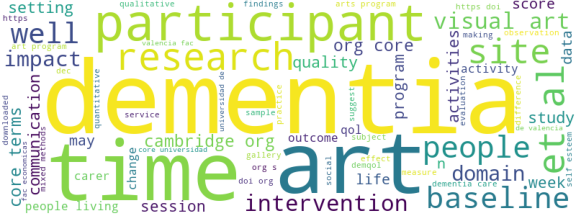| Id | 947 | |
| Author | Windle G., Joling K.J., Howson-Griffiths T., Woods B., Jones C.H., Van De Ven P.M., Newman A., Parkinson C. | |
| Title | The impact of a visual arts program on quality of life, communication, and well-being of people living with dementia: A mixed-methods longitudinal investigation | |
| Reference | Windle G., Joling K.J., Howson-Griffiths T., Woods B., Jones C.H., Van De Ven P.M., Newman A., Parkinson C.; The impact of a visual arts program on quality of life, communication, and well-being of people living with dementia: A mixed-methods longitudinal investigation ;International Psychogeriatrics vol:30 issue: 3 page:409.0 |
|
| Link to article | https://www.scopus.com/inward/record.uri?eid=2-s2.0-85034611722&doi=10.1017%2fS1041610217002162&partnerID=40&md5=b74a055562cda4e6ac2accf8ab8200dd |
|
| Abstract | Background: Research reviews highlight methodological limitations and gaps in the evidence base for the arts in dementia care. In response, we developed a 12-week visual art program and evaluated the impact on people living with dementia through a mixed-methods longitudinal investigation.Methods: One hundred and twenty-five people living with mild to severe dementia were recruited across three research settings in England and Wales (residential care homes, a county hospital, and community venues). Quantitative and qualitative data on quality of life (QoL), communication and perceptions of the program were obtained through interviews and self-reports with participants and their carers. Eight domains of well-being were measured using a standardized observation tool, and data compared to an alternative activity with no art.Results: Across all sites, scores for the well-being domains of interest, attention, pleasure, self-esteem, negative affect, and sadness were significantly better in the art program than the alternative condition. Proxy-reported QoL significantly improved between baseline and 3-month follow-up, but no improvements in QoL were reported by the participants with dementia. This was contrasted by their qualitative accounts, which described a stimulating experience important for social connectedness, well-being, and inner-strength. Communication deteriorated between baseline and follow-up in the hospital setting, but improved in the residential care setting.Conclusions: The findings highlight the potential for creative aging within dementia care, the benefits of art activities and the influence of the environment. We encourage dementia care providers and arts and cultural services to work toward embedding art activities within routine care provision. Copyright © International Psychogeriatric Association 2017. |
|
| Keywords | art; dementia; intervention; longitudinal; mixed-methods; quality of life; well-being |
Wordcloud:



